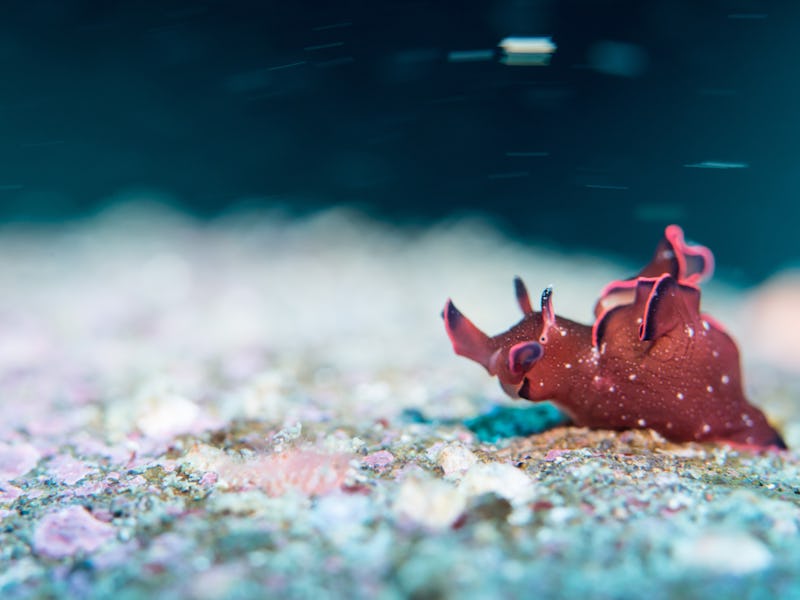Sea slugs reveal a strange connection between food comas and memory storage
This could help us better understand our own metabolism.

It’s a feeling we’ve all experienced at some point: After a big, carbohydrate-laden meal, all you want to do is curl up someplace warm and take a long nap. It’s only natural, say scientists, and it may in fact be an evolutionary reaction that helped our non-mammalian relatives store long-term memories.
In research published Monday in the journal Scientific Reports, scientists found that a species of sea slug called the California sea hare (Aplysia californica) responds to the human body’s two forms of insulin, the hormone itself and insulin-like growth factor II (IGF2), in a significantly different way than humans do. They suspect that this difference can tell us a lot about how our metabolic habits came to be the way they are.
In humans, these two forms of insulin are used separately, but when investigating the sea slug’s metabolic and neurotropic responses, researchers found that it had a unified insulin system. They say this suggests that the mammalian ‘rest-and-digest’ response that leaves us feeling sluggish after a big meal may be left over from our once-unified systems as well.
“Our new study proposes that such ‘rest-and-digest’ responses to feeding may have been shaped by evolution to promote the formation of long-term memories,” Thomas Carew, Ph.D., professor of neural science and psychology at New York University and the paper’s senior author, said in a press release.
Here’s how they reached that conclusion.
We don't look or act much like the California sea hare, but it can teach us a thing or two about our own metabolism.
In humans, these two forms of insulin have evolved into two separate systems: one for metabolic processes and one for neurotropic ones. Specifically, in humans researchers have found no connection between insulin and brain function, but they have observed a connection between IGF2 and brain function — though that growth factor is not triggered by calorie consumption as regular insulin is.
In short, this means that in humans there appears to be little connection between eating and memory storage.
When investigating why this might not be the case for sea slugs, the researchers observed their behavior during different feeding sessions. They observed that after the slugs were allowed to eat their fill of seaweed, their activity levels began to drop as energy was refocused instead from eating to absorbing nutrients and storing memories.
“Thus, Aplysia’s ‘food coma’ is controlled by their insulin-like system, which acts by redistributing the animal’s energy away from active behavior and towards storage of both nutrients and memory,” Carew said. “These results will help understand the mechanisms by which insulin and similar molecules elicit both their diet-related and memory-enhancing properties in humans and other animals.”
Unlike their human counterparts, the sea slugs gorged on seaweed. But they got sleepy all the same.
While this may have been observed in sea slugs, there’s still much work to be done to connect this feeding reaction to that of mammals, let alone humans. But, if anything, it might help explain why we get so tired after eating a big meal. Similar to how sleeping can help us catalog our memories, the authors suggest that resting after a big meal may have a similar function.
Or, at least the feeling may be a vestigial reaction from when our insulin systems might have once also been connected.
“Perhaps the drowsiness experienced after a meal is a similar way to preserve a memory about that meal, so as to come back to it in the future,” Carew suggests. “Whether seaweed or Thanksgiving turkey, a good dinner is always worth revisiting.”
Abstract:
Insulin-like growth factor II (IGF2) enhances memory in rodents via the mannose-6-phosphate receptor (M6PR), but the underlying mechanisms remain poorly understood. We found that human IGF2 produces an enhancement of both synaptic transmission and neurite outgrowth in the marine mollusk Aplysia californica. These findings were unexpected since Aplysia lack the mammal-specific affinity between insulin-like ligands and M6PR. Surprisingly, this effect was observed in parallel with a suppression of neuronal excitability in a well-understood circuit that supports several temporally and mechanistically distinct forms of memory in the defensive withdrawal reflex, suggesting functional coordination between excitability and memory formation. We hypothesize that these effects represent behavioral adaptations to feeding that are mediated by the endogenous Aplysia insulin-like system. Indeed, the exogenous application of a single recombinant insulin-like peptide cloned from the Aplysia CNS cDNA replicated both the enhancement of synaptic transmission, the reduction of excitability, and promoted clearance of glucose from the hemolymph, a hallmark of bona fide insulin action.